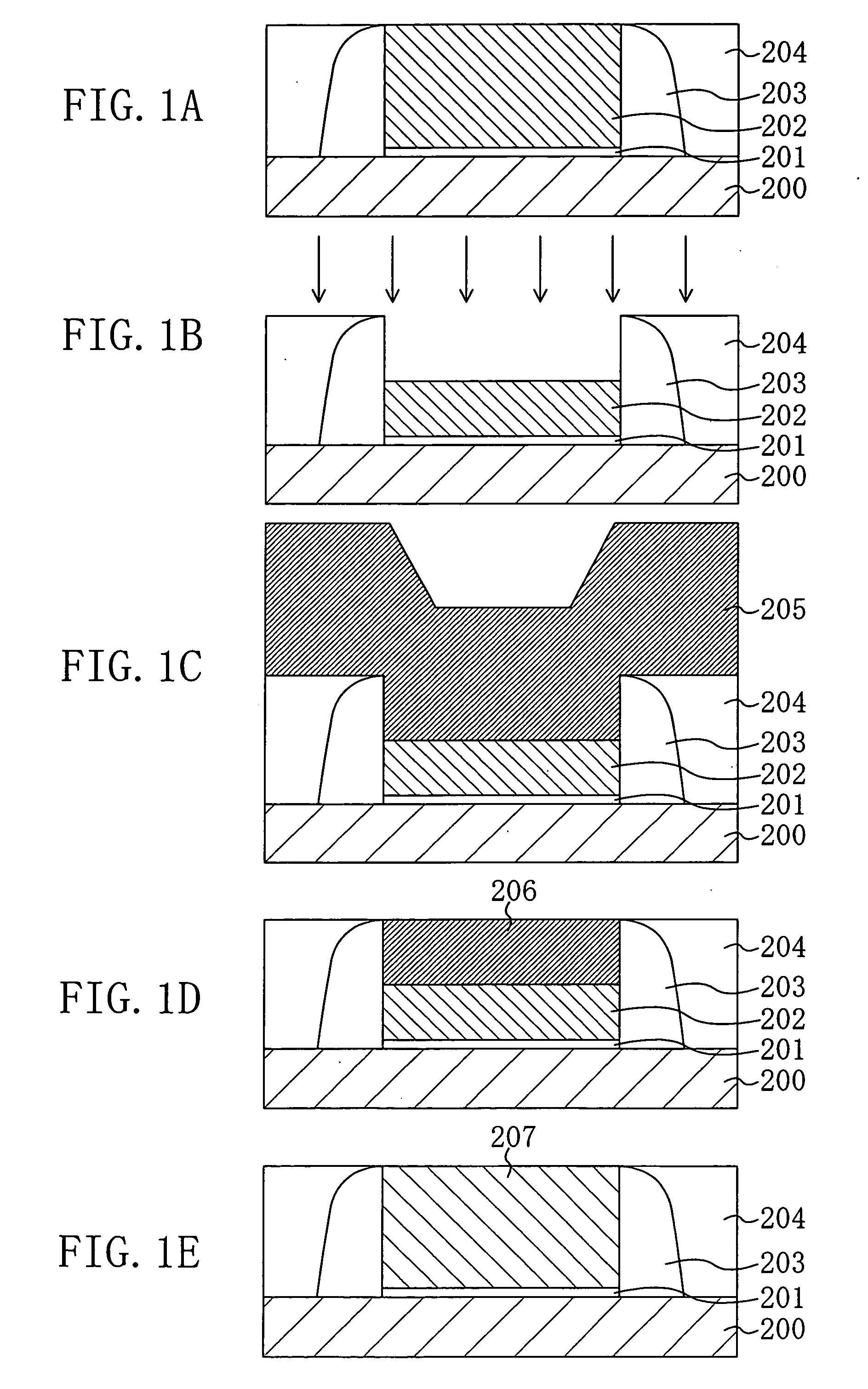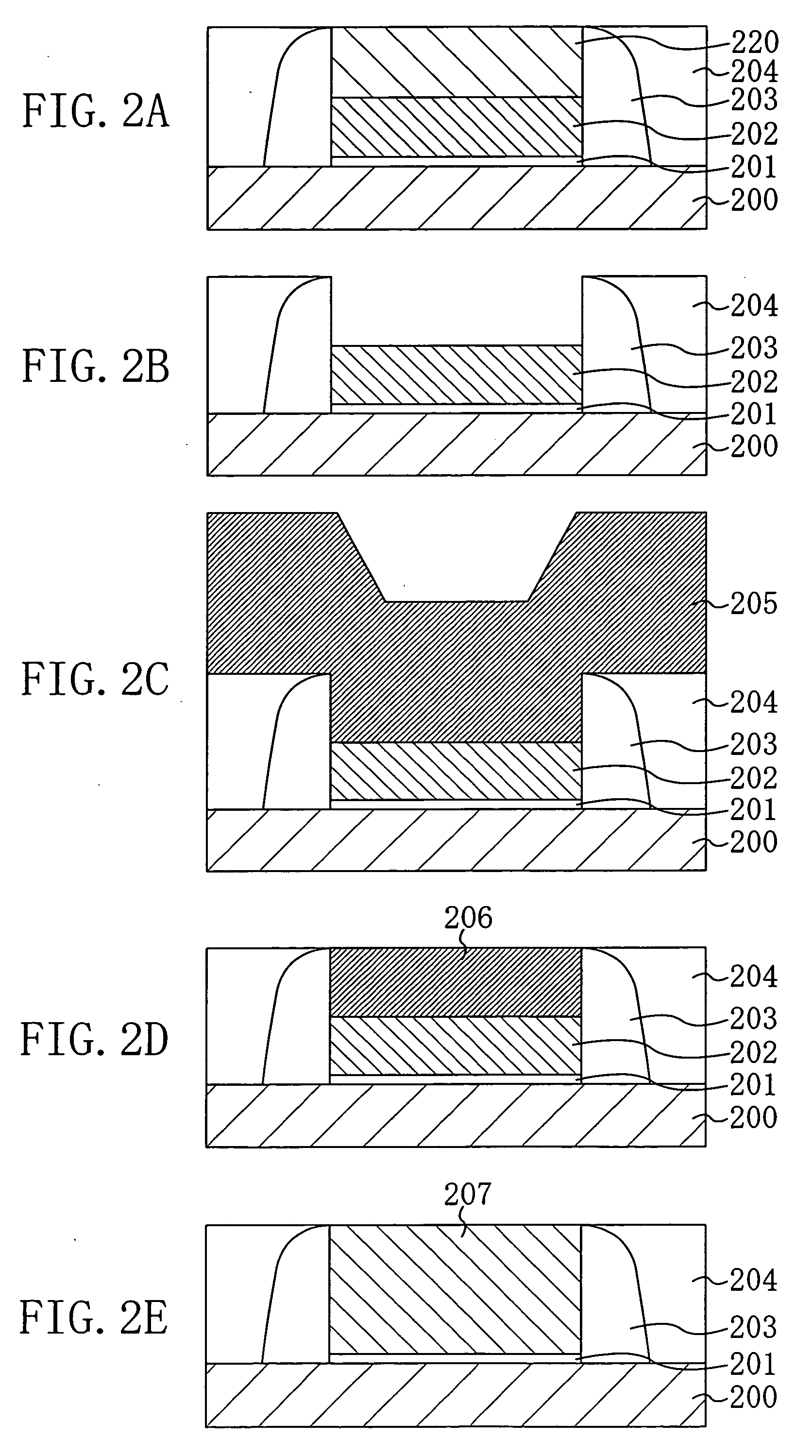Method for fabricating semiconductor device and semiconductor device
- Summary
- Abstract
- Description
- Claims
- Application Information
AI Technical Summary
Benefits of technology
Problems solved by technology
Method used
Image
Examples
embodiment 1
[0025] Hereinafter, a method for fabricating a semiconductor device according to a first embodiment of the present invention will be described with reference to the drawings.
[0026]FIGS. 1A through 1E are cross-sectional views showing a method for fabricating a semiconductor device according to the first embodiment.
[0027] First, as illustrated in FIG. 1A, a SiON film with a thickness of 2 nm and a polysilicon layer with a thickness of 100 nm are deposited over a semiconductor substrate 200 made of, for example, silicon (Si). Then, the SiON film and the polysilicon layer are partially etched, thereby forming a gate insulating film 201 with a thickness of about 2 nm and a silicon gate 202 with a thickness of 100 nm and a gate length of about 100 nm. Thereafter, extension implantation is performed using the silicon gate 202 as a mask, and then sidewalls 203 made of an insulating film and having a height of 100 nm are formed on side faces of the gate insulating film 201 and the silicon...
modified example of embodiment 1
[0039]FIGS. 2A through 2E are cross-sectional views showing a method for fabricating a semiconductor device according to a modified example of the first embodiment. This modified example is different from the first embodiment in process steps up to the formation of the silicon gate 202.
[0040] First, as illustrated in FIG. 2A, a SiON film with a thickness of 2 nm and a polysilicon layer with a thickness of 50 nm are deposited over a semiconductor substrate 200. Then, a phospho-silicate glass (PSG) layer with a thickness of 50 nm is formed on the polysilicon layer. Thereafter, the PSG layer, the polysilicon layer and the SiON film are partially etched, thereby forming a gate insulating film 201 with a thickness of 2 nm, a silicon gate 202 with a thickness of 50 nm and a protective layer 220 with a thickness of 50 nm, respectively. Subsequently, extension implantation is performed using the silicon gate 202 and the protective layer 220 as masks. Then, sidewalls 203 of an insulating fi...
embodiment 2
[0044] Hereinafter, a method for fabricating a semiconductor device according to a second embodiment of the present invention will be described with reference to the drawings. FIGS. 3A through 3H are cross-sectional views showing a method for fabricating a semiconductor device according to the second embodiment. The method of this embodiment is directed to a method for fabricating a MIS transistor including FUSI gate electrodes having different silicide phases on a wafer. In this embodiment, a NiSi phase is used for a gate electrode of an n-channel MIS (nMIS) transistor and a Ni3Si phase is used for a gate electrode of a p-channel MIS (pMIS) transistor. In each of FIGS. 3A through 3H, an nMIS region is shown in the left side and a pMIS region is shown in the right side.
[0045] First, as illustrated in FIG. 3A, in the same manner as in the first embodiment, a first gate insulating film 301a, a first silicon gate 302 of polysilicon, first sidewalls 304a and source / drain regions (not s...
PUM
 Login to View More
Login to View More Abstract
Description
Claims
Application Information
 Login to View More
Login to View More - R&D
- Intellectual Property
- Life Sciences
- Materials
- Tech Scout
- Unparalleled Data Quality
- Higher Quality Content
- 60% Fewer Hallucinations
Browse by: Latest US Patents, China's latest patents, Technical Efficacy Thesaurus, Application Domain, Technology Topic, Popular Technical Reports.
© 2025 PatSnap. All rights reserved.Legal|Privacy policy|Modern Slavery Act Transparency Statement|Sitemap|About US| Contact US: help@patsnap.com



